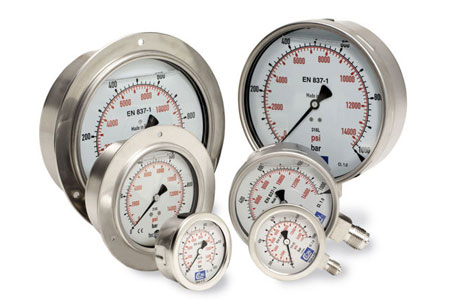How To Troubleshoot A Faulty Pressure Gauge?
Key Takeaway
To troubleshoot a faulty pressure gauge, start by checking for visible damage, such as leaks or broken parts. Verify the connection and ensure no blockages in the pressure line.
Test the gauge with a known pressure source to confirm accuracy. If errors persist, recalibrate or replace the gauge based on its condition and usage.
Identifying Symptoms of a Faulty Pressure Gauge
Identifying symptoms of a faulty pressure gauge is crucial for maintaining the safety and efficiency of systems that rely on accurate pressure measurements. A pressure gauge is a device used to measure the pressure of a fluid within a system, and any inaccuracies can lead to significant issues.
Common symptoms of a faulty pressure gauge include erratic readings, a stuck needle, or a gauge that does not return to zero. Other signs may include visible damage to the gauge or inconsistent readings compared to other gauges in the same system. By recognizing these symptoms early, users can take corrective action to prevent potential system failures or safety hazards.

Tools Needed for Troubleshooting
To troubleshoot a faulty pressure gauge effectively, you’ll need a few essential tools:
1. Calibrator: A pressure calibrator is crucial for verifying the accuracy of the gauge. It helps you compare the gauge reading to the actual pressure.
2. Wrenches and Spanners: To disconnect and replace fittings or seals, you may need adjustable wrenches and spanners of different sizes.
3. Sealing Tape or Thread Sealant: In cases where you need to replace or reseal fittings, sealing tape or thread sealant can help prevent leaks.
4. Multimeter: For digital gauges, a multimeter is used to check electrical connections and detect issues with the sensor or wiring.
5. Cleaning Supplies: Dirt or debris can cause mechanical issues within the gauge. Brushes, cloths, and compressed air can help clean internal components.
Step-by-Step Troubleshooting Guide
Once you’ve identified symptoms and gathered the necessary tools, follow these steps to troubleshoot your faulty pressure gauge:
1. Step 1: Isolate the Gauge: First, ensure that the gauge is safely isolated from the system. Shut off any relevant valves and ensure that there is no pressure in the line before starting any work.
2. Step 2: Inspect for Visible Damage: Check the pressure gauge for any obvious signs of damage, such as cracks, leaks, or corrosion. If the gauge is physically damaged, it may need to be replaced.
3. Step 3: Clean the Gauge: If dirt or debris is visible, clean the gauge carefully with a brush or compressed air. Be sure not to damage any delicate components inside the gauge.
4. Step 4: Verify Calibration: Use a pressure calibrator to check if the gauge is reading accurately. Compare the gauge reading to the actual pressure in the system. If there is a discrepancy, recalibration may be necessary.
5. Step 5: Check for Leaks or Seal Issues: Inspect the seals and fittings around the gauge to ensure that they are intact and free from leaks. Tighten any loose fittings and replace damaged seals if needed.
6. Step 6: Examine the Internal Mechanism: If the needle is sticking or moving erratically, you may need to remove the gauge casing and inspect the internal spring, diaphragm, or Bourdon tube. Clean and lubricate as necessary, or replace worn-out parts.
7. Step 7: Test the Gauge Again: After performing all checks and adjustments, test the gauge again to ensure it is operating correctly. If the gauge still doesn’t provide accurate readings, it may be time to replace it.
When to Repair vs. Replace a Faulty Gauge
Deciding whether to repair or replace a faulty pressure gauge depends on several factors:
1. Age and Condition of the Gauge: If the gauge is old or significantly damaged, replacement is often the better option. A worn-out gauge may not be worth repairing.
2. Cost of Repair: Consider the cost of repairing the gauge versus purchasing a new one. If the repair costs are too high or the gauge is beyond repair, replacement is the best choice.
3. Frequency of Failures: If the gauge has failed multiple times, it may indicate that it’s time for a more reliable model. Frequent breakdowns can lead to prolonged downtime and increased maintenance costs.
4. Availability of Parts: If replacement parts for the gauge are no longer available, replacement of the entire unit may be the only option.
When in doubt, consult the manufacturer’s guidelines or a professional technician to help you determine whether a repair or replacement is more cost-effective.
Preventive Measures to Avoid Future Issues
Once your pressure gauge is back in working order, implementing preventive measures will help extend its life and ensure long-term accuracy. Here are a few steps to keep in mind:
1. Regular Calibration: Make sure to calibrate your pressure gauges at regular intervals to maintain their accuracy.
2. Protect from Extreme Conditions: Place pressure gauges in areas free from harsh temperatures, excessive vibrations, or corrosive substances.
3. Routine Inspections: Schedule regular inspections to check for leaks, mechanical wear, or damage. Early detection of issues will prevent bigger problems later on.
4. Use the Right Gauge for the Job: Ensure that the pressure gauge you use is suitable for the specific conditions of your system. Consider factors like pressure range, material compatibility, and environmental factors when selecting a gauge.
Conclusion
Troubleshooting a faulty pressure gauge involves several steps to identify and resolve the issue. Begin by checking for visible signs of damage, such as cracks or leaks in the gauge or its connections. Ensure that the gauge is properly installed and that there are no blockages or obstructions in the pressure line.
If the gauge is still not functioning properly, consider recalibration or replacement. In some cases, environmental factors such as extreme temperatures or vibrations may affect gauge performance. Addressing these factors and performing regular maintenance can prevent future issues and ensure accurate pressure readings.

